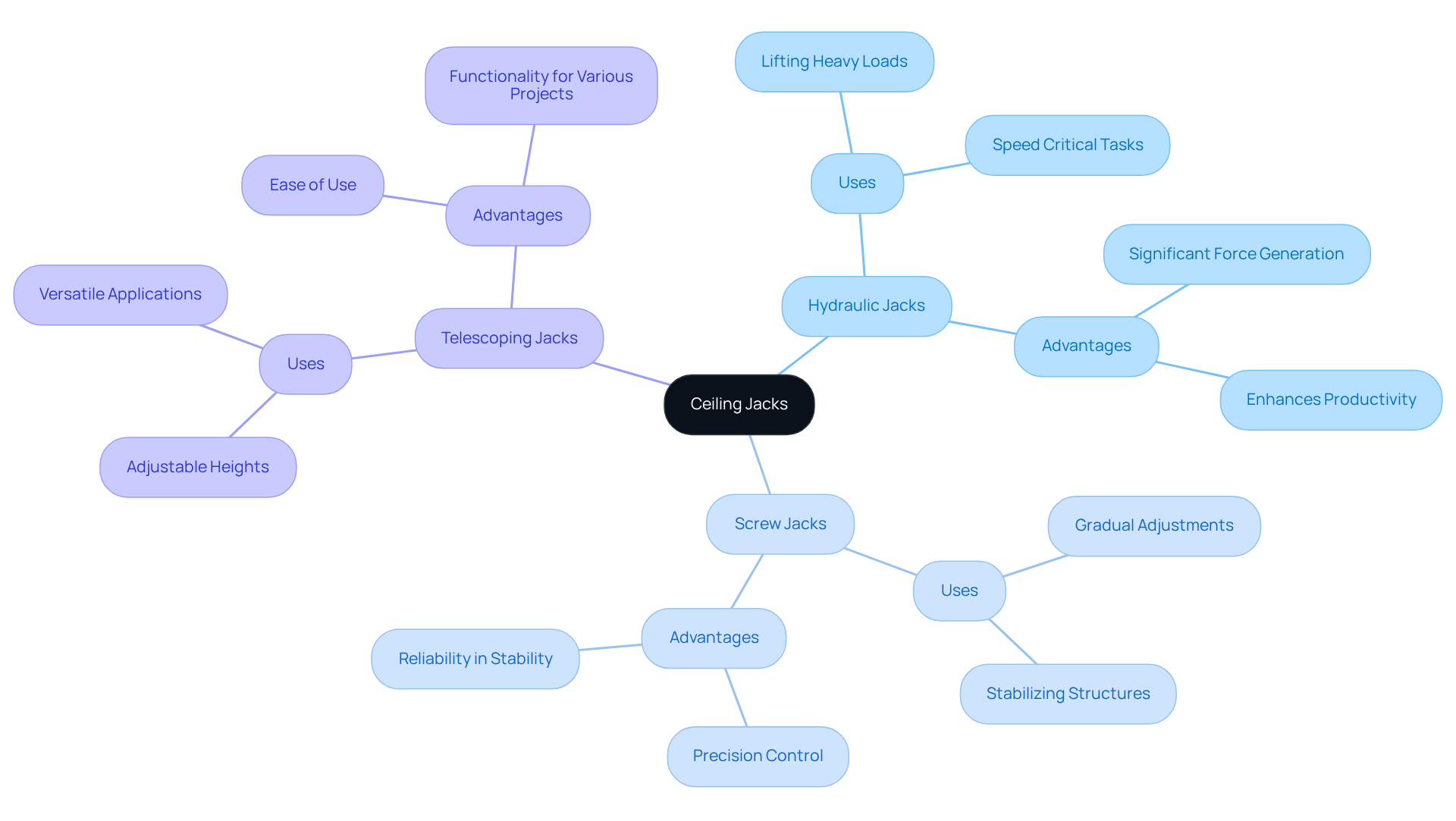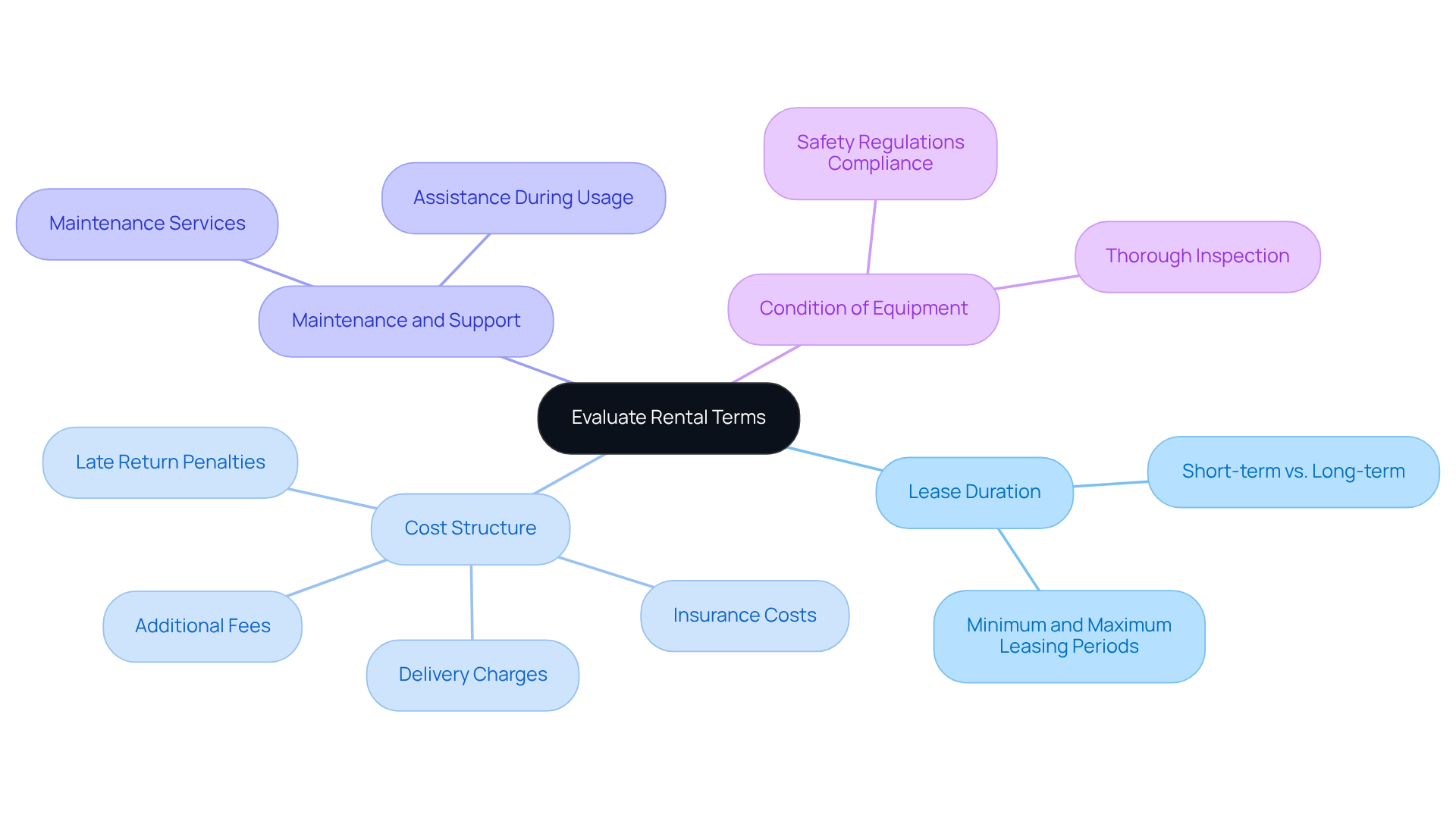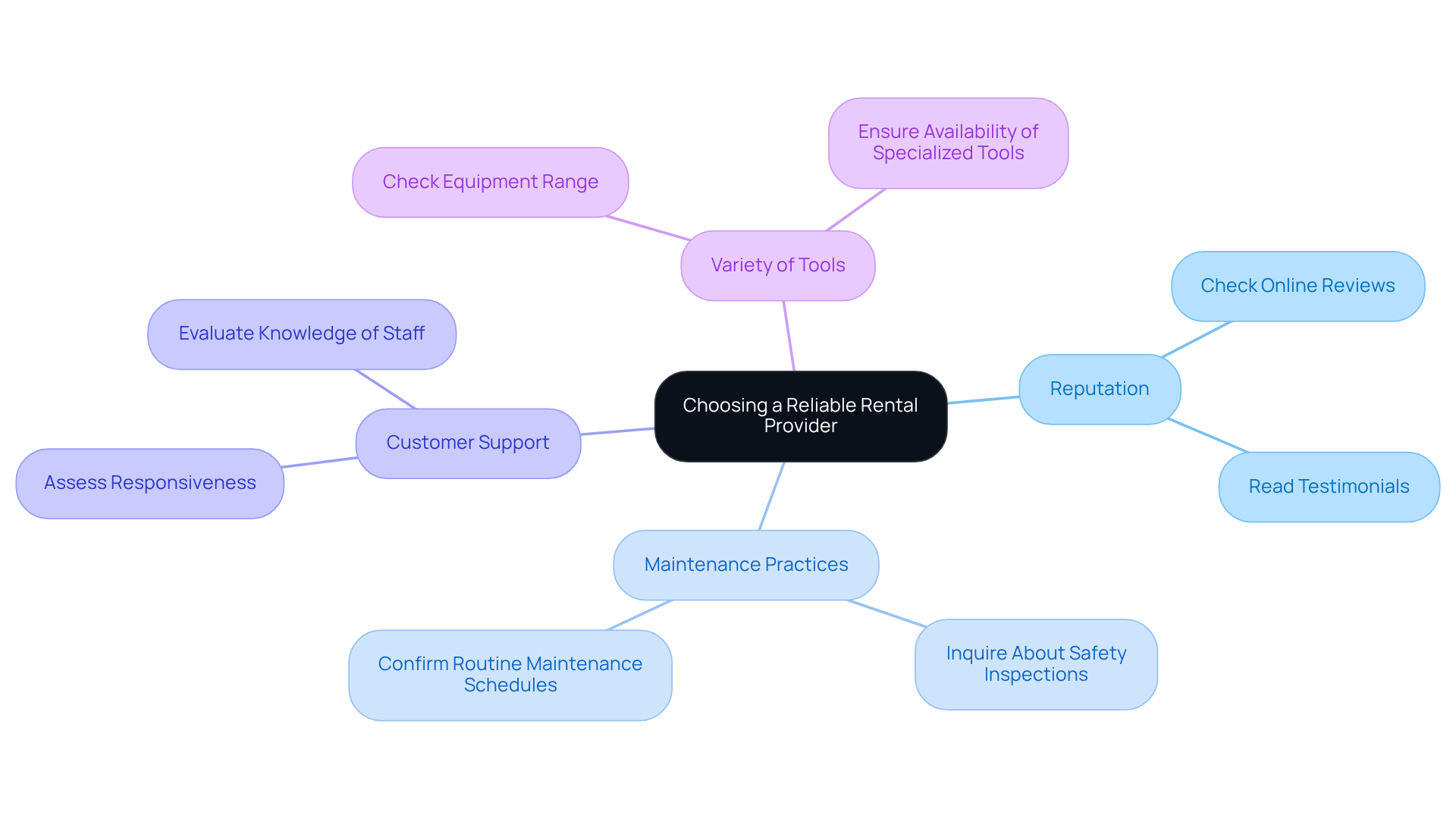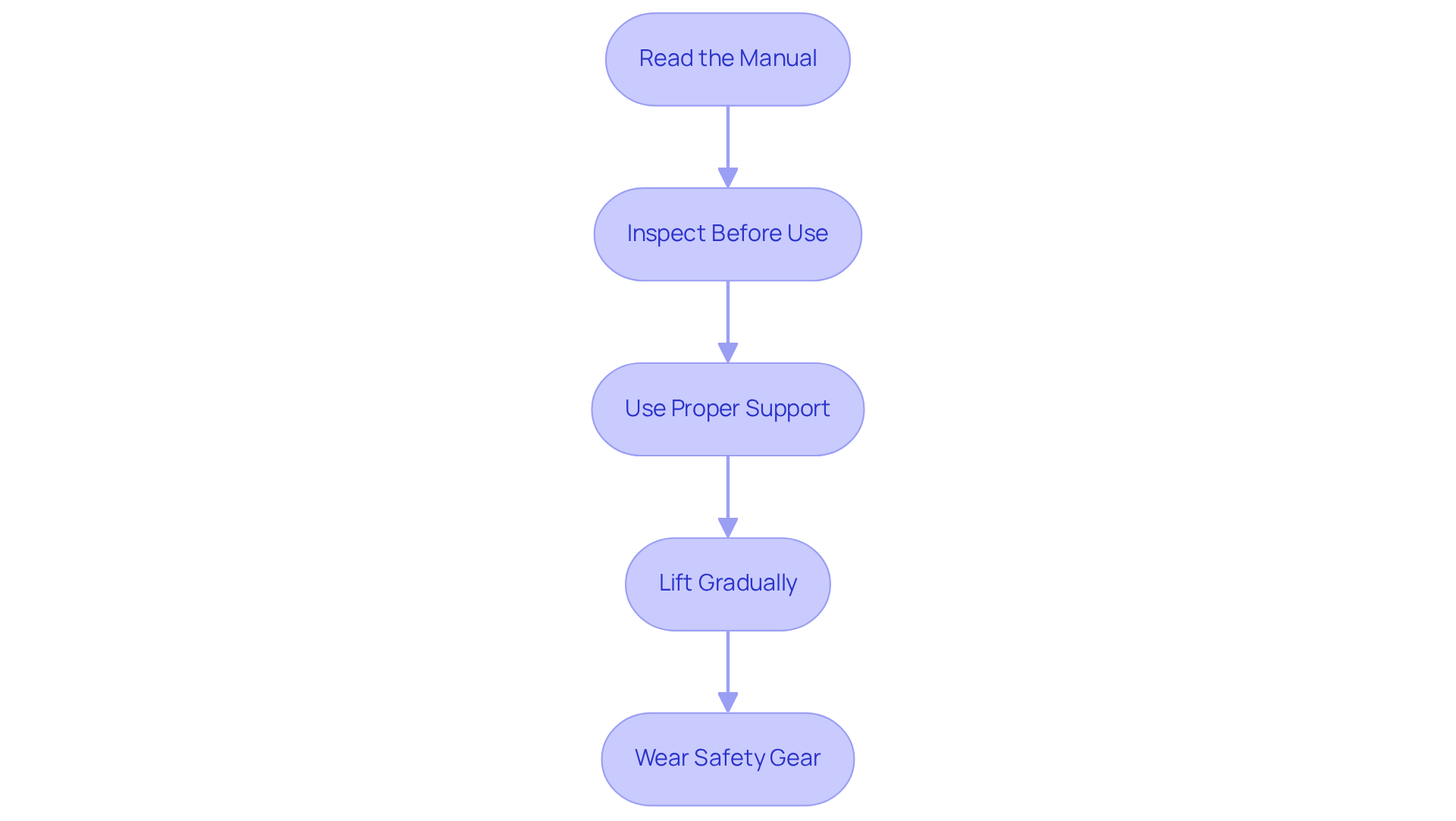Overview
This article presents four best practices for effectively utilizing ceiling jacks for rent.
- First, it is crucial to understand the various types of jacks available. Each type offers unique benefits tailored to specific project needs.
- Next, evaluating rental terms is essential; project managers must consider factors such as duration, costs, and conditions of use to make informed decisions.
- Choosing a reliable provider cannot be overstated. A provider’s reputation and support play a significant role in ensuring a smooth rental experience. It is advisable to research customer testimonials and case studies that highlight the reliability and quality of service.
- Furthermore, implementing safety measures during use is paramount. Adhering to essential safety protocols not only safeguards personnel but also contributes to successful project outcomes.
In conclusion, these best practices are designed to enhance your experience with ceiling jacks for rent. By understanding the types of jacks, evaluating rental terms, selecting a trustworthy provider, and prioritizing safety, you position yourself for success. Engage with a reputable provider today to ensure your project runs smoothly and efficiently.
Key Highlights:
- Ceiling jacks are categorised into hydraulic, screw, and telescoping types, each designed for specific tasks.
- Hydraulic jacks are preferred for quick lifting of heavy loads due to their efficiency.
- Screw jacks allow for precise adjustments, making them ideal for stabilising structures.
- Telescoping jacks offer adjustable heights, catering to various project needs.
- Project managers should consider lease duration, cost structure, maintenance support, and equipment condition when renting ceiling jacks.
- A reliable rental provider should have a good reputation, adhere to maintenance practises, provide strong customer support, and offer a variety of tools.
- Best practises for using ceiling jacks include reading the manual, inspecting equipment, ensuring proper support, lifting gradually, and wearing safety gear.
Introduction
Ceiling jacks are essential tools in construction and renovation projects; however, many users remain unaware of the nuances that can significantly impact their effectiveness. Understanding the various types of ceiling jacks and their specific applications is crucial for enhancing safety and efficiency on the job site.
With numerous options and rental considerations to navigate, project managers must ensure they make informed choices tailored to their needs. This article explores best practices for using ceiling jacks effectively, offering insights that can elevate project outcomes while safeguarding against potential pitfalls.
Understand Ceiling Jacks: Types and Uses
Ceiling jacks are essential tools available in a variety of types, each meticulously designed for specific tasks. Understanding these categories is crucial for selecting the right equipment for projects such as raising ceilings, supporting beams, or stabilizing structures during renovations.
-
Hydraulic Jacks stand out as the premier choice for lifting heavy loads swiftly. These jacks utilize hydraulic fluid to generate significant force, making them indispensable in scenarios where speed is critical. Their efficiency ensures that tasks are completed in a timely manner, enhancing productivity on any job site.
-
Screw Jacks offer unparalleled precision, providing users with the ability to make gradual adjustments with ease. Ideal for stabilizing structures over time, these jacks are favored by professionals who require meticulous control during their projects. Their reliability in maintaining stability cannot be overstated, making them a vital addition to any toolkit.
-
Telescoping Jacks are designed for versatility, featuring adjustable heights that accommodate various room dimensions. This adaptability makes them a favorite among contractors and DIY enthusiasts alike, as they can be tailored to meet the specific needs of any project. Their ease of use and functionality ensure that they are always ready for action.
By comprehending these categories, you can make informed decisions that enhance the quality and safety of your work. Whether you need to lift, support, or stabilize, selecting the appropriate ceiling jack is paramount to achieving successful outcomes. Engage with us today to explore our extensive range of ceiling jacks for rent and elevate your projects to new heights.

Evaluate Rental Terms: Key Considerations for Project Managers
When renting ceiling jacks for rent, project managers must evaluate several key terms to ensure successful project execution.
-
Lease Duration: It is essential to understand the minimum and maximum leasing periods. Short-term leases may incur higher daily rates, while long-term accommodations often yield substantial savings. Aligning the lease duration for ceiling jacks for rent with project timelines is crucial for financial efficiency.
-
Cost Structure: Familiarize yourself with the complete cost structure, including any additional fees such as delivery charges, insurance, or late return penalties. A comprehensive understanding of these costs, including ceiling jacks for rent, is vital to ensure that the overall leasing expense aligns with the project's budget.
-
Maintenance and Support: Inquire whether the leasing company provides maintenance services or assistance during the usage period. Access to reliable maintenance is vital for minimizing downtime and ensuring that the equipment operates efficiently throughout the project.
-
Condition of Equipment: Always conduct a thorough inspection of the equipment prior to rental. Ensuring that the ceiling jacks for rent comply with safety regulations and are in peak working order is critical for both safety and operational efficiency.
By considering these factors, project managers can make informed decisions that enhance project outcomes and maintain budgetary control.

Choose a Reliable Rental Provider: Ensuring Quality and Support
Selecting a reliable rental provider for ceiling jacks is crucial for ensuring project success. Begin by investigating the provider's reputation through online reviews and testimonials. A company with a strong track record of positive feedback is more likely to deliver quality equipment and exceptional service.
Next, confirm that the provider adheres to rigorous maintenance practices. Inquire about their routine maintenance schedules and whether they perform comprehensive safety inspections before each use. This diligence ensures that the equipment is in optimal condition, ready to meet your project needs.
Furthermore, assess the level of customer support available. A responsive and knowledgeable provider can significantly enhance your rental experience by swiftly addressing any issues that may arise, ensuring that you are never left in the lurch.
Finally, choose a provider that presents a varied assortment of lifts and associated tools. This variety allows for greater flexibility in meeting the specific needs of your project, ensuring you have the right tools at your disposal. By considering these key factors, you are well on your way to making an informed decision that will contribute to the success of your project.

Implement Best Practices: Safe and Efficient Use of Ceiling Jacks
To ensure the safe and efficient use of ceiling jacks, it is imperative to follow best practices that guarantee reliability and safety.
-
Read the Manual: Always consult the manufacturer's manual for specific instructions on using the device. Understanding the equipment's capabilities and limitations is crucial for effective operation.
-
Inspect Before Use: Conduct a thorough examination of the device before each use. Check for any signs of wear, damage, or malfunction to prevent accidents and ensure optimal performance.
-
Use Proper Support: Ensure that the jack is placed on a stable surface and that it is adequately supported. This step is essential to prevent tipping or collapsing during operation.
-
Lift Gradually: When lifting, do so gradually. Sudden shifts in weight can lead to structural damage or accidents, so a careful approach is necessary.
-
Wear Safety Gear: Always wear appropriate safety gear, including hard hats, gloves, and non-slip footwear. This precaution protects against potential hazards and ensures a safer working environment.

Conclusion
Understanding the effective use of ceiling jacks is vital for anyone involved in construction and renovation projects. Selecting the appropriate type of ceiling jack—whether hydraulic, screw, or telescoping—ensures safety and efficiency in lifting, supporting, or stabilizing structures. The significance of making informed decisions when renting these tools cannot be overstated; it directly impacts project success and budget adherence.
Key considerations for project managers include:
- Evaluating rental terms such as lease duration.
- Cost structure.
- Maintenance support.
- The condition of the equipment.
Choosing a reliable rental provider who prioritizes quality and customer service enhances the experience, ensuring that the necessary tools are available and in optimal condition. Implementing best practices during the use of ceiling jacks, including thorough inspections and gradual lifting techniques, safeguards against accidents and promotes operational efficiency.
Ultimately, the effective use of ceiling jacks can significantly elevate project outcomes. By adhering to best practices and making informed rental choices, professionals not only enhance their workflow but also ensure a safer working environment. Embracing these insights leads to more successful and productive projects, reinforcing the importance of preparation and diligence in equipment rental and usage.
Frequently Asked Questions
What are ceiling jacks and why are they important?
Ceiling jacks are essential tools designed for specific tasks such as raising ceilings, supporting beams, or stabilizing structures during renovations. Understanding their types is crucial for selecting the right equipment for various projects.
What are the different types of ceiling jacks?
The main types of ceiling jacks are Hydraulic Jacks, Screw Jacks, and Telescoping Jacks, each serving distinct purposes.
What are Hydraulic Jacks used for?
Hydraulic Jacks are used for lifting heavy loads swiftly, utilizing hydraulic fluid to generate significant force. They are essential in scenarios where speed is critical and enhance productivity on job sites.
How do Screw Jacks differ from other types?
Screw Jacks offer precision and allow for gradual adjustments, making them ideal for stabilizing structures over time. They are favored by professionals who need meticulous control during projects.
What advantages do Telescoping Jacks provide?
Telescoping Jacks are versatile, featuring adjustable heights that accommodate various room dimensions. Their adaptability makes them popular among contractors and DIY enthusiasts for different project needs.
Why is it important to choose the right ceiling jack?
Selecting the appropriate ceiling jack is paramount for achieving successful outcomes in lifting, supporting, or stabilizing structures, which enhances the quality and safety of the work.




